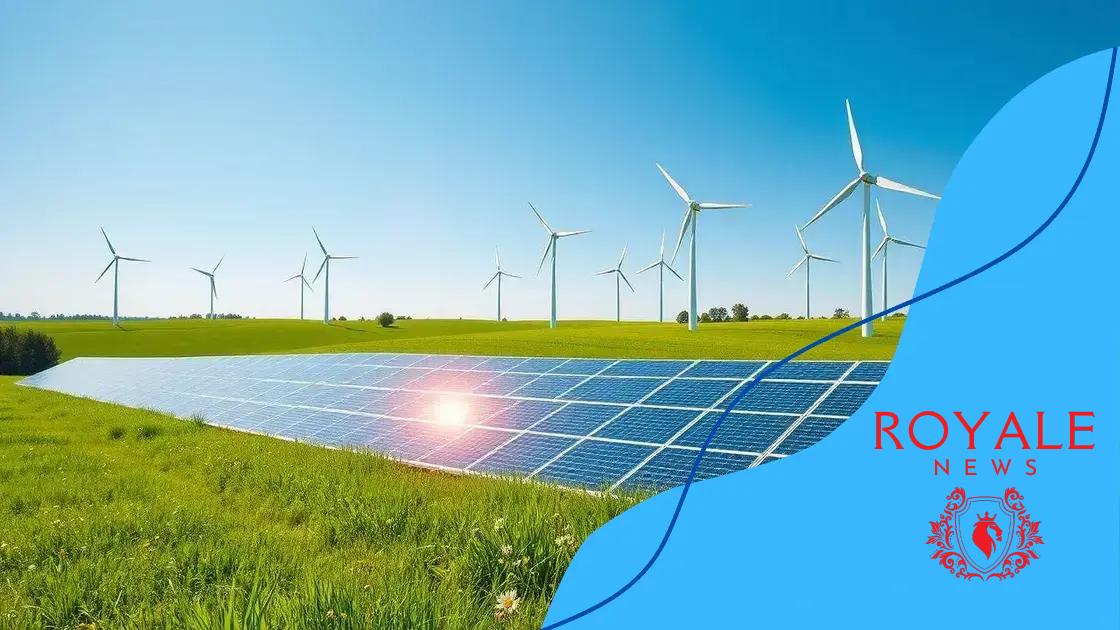Green tech breakthroughs in renewable energy

Green tech breakthroughs in renewable energy include advancements in solar, wind, and bioenergy technologies that enhance efficiency, reduce carbon footprints, and support sustainable practices for a cleaner future.
Green tech breakthroughs in renewable energy are reshaping our approach to sustainability and environmental conservation. Have you ever wondered how these innovations could change your daily life and our planet’s future?
Understanding green tech in renewable energy
Understanding green tech in renewable energy is essential for those who want to explore sustainable solutions. This innovative field focuses on using environmentally-friendly technologies to harness natural resources effectively.
Green tech encompasses various renewable energy sources, including solar, wind, and hydroelectric power. Each type of technology plays a significant role in reducing our reliance on fossil fuels while promoting sustainability.
Key Components of Green Tech
Among the critical components are:
- Solar Panels: These convert sunlight into electricity and can be installed on rooftops or in solar farms.
- Wind Turbines: These generate power by harnessing wind energy, often found in large wind farms.
- Hydroelectric Systems: These use flowing water to generate electricity, combining technology with nature.
Understanding the specific applications of these technologies helps individuals and businesses make informed choices. For example, solar energy systems can significantly reduce electricity bills, while wind energy can provide sustainable power for entire communities.
Benefits of Green Technologies
There are numerous benefits behind the implementation of green tech. First, they help decrease greenhouse gas emissions, improving air quality. Additionally, these technologies are often renewable, meaning they can be replenished naturally.
Many regions are now investing in green tech innovations to stimulate local economies. This shift not only creates jobs but also encourages communities to embrace sustainable practices. With advancements in these technologies, individuals can contribute to a cleaner, healthier planet while enjoying lower energy costs.
Innovative solar power solutions
Innovative solar power solutions are reshaping how we harness energy from the sun. With technology advancing rapidly, solar energy is becoming more accessible and efficient than ever before.
Solar energy is essential for those looking to reduce their carbon footprint. Modern systems now include advanced solar panels that can capture sunlight even on cloudy days. These improvements make solar power a reliable energy source.
Types of Solar Technologies
Several types of solar technologies are leading the way in this revolution:
- Photovoltaic (PV) Panels: These convert sunlight directly into electricity, making them perfect for residential and commercial use.
- Concentrated Solar Power (CSP): This technology uses mirrors to focus sunlight onto a small area, generating heat which can then produce electricity.
- Building-Integrated Photovoltaics (BIPV): These systems integrate solar cells into the building materials, allowing structures to generate energy without traditional rooftop panels.
Adopting these innovative solutions can provide numerous benefits, including lower energy bills and increased property value. Homeowners often find that installing solar panels enhances their homes’ marketability.
Emerging Trends in Solar Solutions
Emerging trends show a strong shift towards solar battery storage systems. By storing excess energy generated during sunny days, homeowners can use it during the night or on cloudy days. This capability maximizes energy use and minimizes reliance on the grid.
Collaboration between local governments and solar companies is also growing. Many areas now provide tax incentives and rebates for solar technology adoption, making it even more appealing for potential users. These partnerships encourage communities to embrace solar solutions, supporting the transition to renewable energy.
Wind energy advancements and their benefits

Wind energy advancements and their benefits are becoming increasingly important as the world seeks sustainable energy solutions. With new technologies emerging, wind energy is paving the way for cleaner power generation.
Recent innovations in wind turbine design have made them more efficient and capable of producing energy in a variety of conditions. These improvements include larger blades and advanced materials that optimize energy capture.
Key Benefits of Wind Energy
Wind energy offers several important benefits:
- Renewable Resource: Wind is a limitless and renewable source of energy that can help reduce reliance on fossil fuels.
- Job Creation: The wind energy sector is a growing industry that creates jobs in manufacturing, installation, and maintenance.
- Reduced Emissions: Utilizing wind energy significantly lowers greenhouse gas emissions, contributing to a healthier environment.
Moreover, wind farms can be built in remote locations, allowing for energy production without disrupting urban areas. As technology advances, smaller, community-based wind energy solutions are also gaining traction. These systems allow neighborhoods or regions to harness their wind resources for local power needs.
The Future of Wind Energy
As innovation continues, the future of wind energy looks promising. Ongoing research aims to enhance turbine efficiency and reduce costs further. Additionally, integrating wind energy with other renewable sources, like solar power, can create hybrid systems that maximize energy production and reliability.
With a focus on sustainability, governments worldwide are investing in wind energy projects. This commitment not only helps meet energy demand but also promotes energy independence and environmental conservation.
The role of bioenergy in sustainability
The role of bioenergy in sustainability is becoming more recognized as we seek alternatives to fossil fuels. Bioenergy offers a renewable source of energy derived from organic materials, which can help reduce greenhouse gas emissions.
Using waste products from agriculture, forestry, and even municipal solid waste can produce bioenergy. This process not only provides energy but also contributes to waste management, making it a dual benefit for communities.
Types of Bioenergy
Bioenergy can be categorized into various forms:
- Biogas: Produced from the anaerobic digestion of organic matter, biogas can power homes and businesses.
- Biofuels: These are liquid fuels made from biomass that can replace gasoline or diesel in vehicles.
- Wood Pellets: Compressed wood fibers that can be burned for heat in residential and industrial applications.
Each of these types plays a significant role in reducing dependency on fossil fuels. As technology improves, the efficiency of converting biomass to energy is continuously increasing.
Benefits of Bioenergy
Implementing bioenergy solutions can offer numerous advantages. They can help in lowering carbon footprints by utilizing carbon-neutral resources. Additionally, bioenergy production can contribute to local economies by creating jobs in farming and processing industries.
By focusing on sustainable practices, bioenergy promotes soil health and provides agricultural waste with a useful application. This creates a cycle of sustainability, where waste is transformed into energy, thus providing a practical solution to energy needs.
Future trends in renewable energy technology
Future trends in renewable energy technology are essential for understanding how we can transition to a more sustainable energy landscape. As technology evolves, new innovations are emerging that promise to transform how we generate and consume energy.
One of the most significant trends is the integration of artificial intelligence (AI) in energy management systems. AI can optimize energy consumption, predict energy needs, and enhance the efficiency of renewable energy sources.
Key Areas of Development
Several areas are showing great promise:
- Energy Storage Technology: Advances in battery technology are allowing for better storage of renewable energy, making it usable even when production is low.
- Smart Grids: These grids use digital technology to manage the production and distribution of energy effectively, integrating various renewable sources seamlessly.
- Hydrogen Production: Green hydrogen, produced using renewable energy, is gaining attention as a potential fuel for transportation and industry, offering a clean alternative to fossil fuels.
Additionally, solar panel technology is evolving rapidly. New materials and designs are being developed to increase efficiency and reduce costs. Innovations like transparent solar cells could revolutionize how buildings harness energy by turning windows into energy-generating surfaces.
Global Initiatives and Collaborations
To support these advancements, many countries are investing in renewable energy research and international collaborations. Global initiatives are forming to share knowledge, technology, and resources to accelerate the transition to sustainable energy systems.
These future trends point toward a cleaner, more efficient energy ecosystem, driven by innovation and collaboration. Engaging communities and stakeholders in this transition will play a crucial role in achieving sustainability goals.
In conclusion, the future of renewable energy is bright, driven by innovative technologies and sustainable practices. Advancements in solar, wind, and bioenergy are paving the way for a cleaner planet. As communities and governments work together to embrace these technologies, we can create a more sustainable energy landscape. Engaging in these practices not only reduces our carbon footprint but also fosters economic growth and job creation. By focusing on renewable energy, we can look forward to a healthier environment and a more sustainable future for generations to come.
FAQ – Frequently Asked Questions about Renewable Energy
What are the main types of renewable energy?
The main types of renewable energy include solar, wind, bioenergy, hydroelectric, and geothermal energy.
How can renewable energy benefit the environment?
Renewable energy reduces greenhouse gas emissions, helping to combat climate change and improve air quality.
What role does technology play in renewable energy advancements?
Technology enhances the efficiency and effectiveness of renewable energy systems, making them more viable and cost-effective.
How can communities engage in renewable energy initiatives?
Communities can engage by supporting local renewable projects, participating in energy cooperatives, and advocating for sustainable policies.





